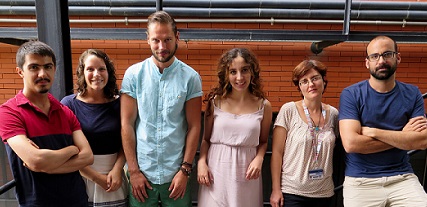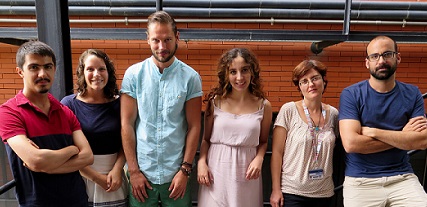Researchers of the Cavanilles Institute of Biodiversity and Evolutionary Biology, in collaboration with the University of Oxford, have published a study in the journal ‘Biology Letters’. It suggests that sex differences in lifespan, a phenomenon of large extent in nature, might be partly due to the protective effect of having two copies of the X chromosome.

Marissa Snyder, Chris Watson,Zahida Sultanova, Ana Hidalgo i Pau Carazo
The study has analysed the lifespan in the common fruit fly (Drosophila melanogaster) males and females. Both were subjected to different inbreeding levels in order to analyse the unguarded X hypothesis proposed 30 years ago to explain the sex differences in lifespan.
The work, published by the Cavanilles Behaviour and Evolution research team of the Universitat de València, shows that this type of flies fulfills one of the fundamental predictions of the hypothesis.
According to this theory, as Pau Carazo, director of the research team puts it, “the sex differences in lifespan might be partly due to the accumulation of mutations throughout the life (over generations). And it affects stronger to the sex with only one copy of the chromosomes, which is named heterogametic. This would be the case of XY male mammals, including human beings.
“If this effect is important to explain the sex differences in lifespan, what we would expect is that inbreeding would affect more to the lifespan of the homogametic sex than to the heterogametic, since the latter is always unprotected regardless of the degree of inbreeding, while the former is only protected when two copies of its X chromosome are distinct (when there is no inbreeding)”, points out Pau Carazo.
In order to study this hypothesis, Cavanilles group made sex differences in lifespan disappeared in their Drosophila flies population. The two copies of the same chromosome were homogenized, provoking them, for instance, to have the same copies -alleles- of each gene. In this way, the protective effect of the second X chromosome in the homogametic sex disappeared.
“This results are consistent with predictions from the unguarded X hypothesis and they suggest that this hypothesis could be fundamental to understand why there are sex differences in lifespan, as well as the lifespan mechanisms in general”.
The reason is that most of the mutations which appear in the DNA are recessives, that is, they only express themselves, and therefore are harmful, when an individual has the same mutation in the two copies of a chromosome. Therefore, having two copies of the same chromosome protects against the expression of recessive mutations, because the presence of one mutation in one of the chromosome would not have consequences. However, having only a copy of the sex chromosome (for instance, men, who only have a X chromosome), would mean that any recessive mutation would be expressed unconditionally.
This study has been supported by the Marie Curie FP7 programme, by the Spanish Government (National Programme for Excellence) and by the UK’s Biological Sciences Research Council.
Research team
The study has been directed by Pau Carazo and conducted in collaboration with researchers of the University of Oxford. Carazo is currently director of the Behaviour and Evolution Lab group (http://paucarazo.com), which belongs to the Ethology unit of the Ecology, Ethology and Evolution group of the Cavanilles Institute of Biodiversity and Evolutionary Biology. The group is currently formed by three PhD students, a laboratory technician and Pau Carazo. Among its lines of research, evolution and function of the sex conflict and lifespan; and the role of behaviour in the evolutionary change are highlighted.
-------------
Article:
Carazo P, Green J, Sepil I, Pizzari T, Wigby S. (2016) «Inbreeding removes sex differences in lifespan in a population of Drosophila melanogaster». Journal of Biosensors and Bioelectronics, 2016, vol. 86, p. 14-19
Link: http://dx.doi.org/10.1098/rsbl.2016.0337
Images:

















